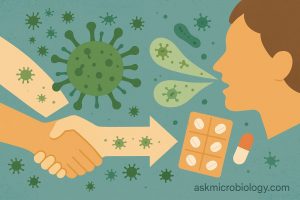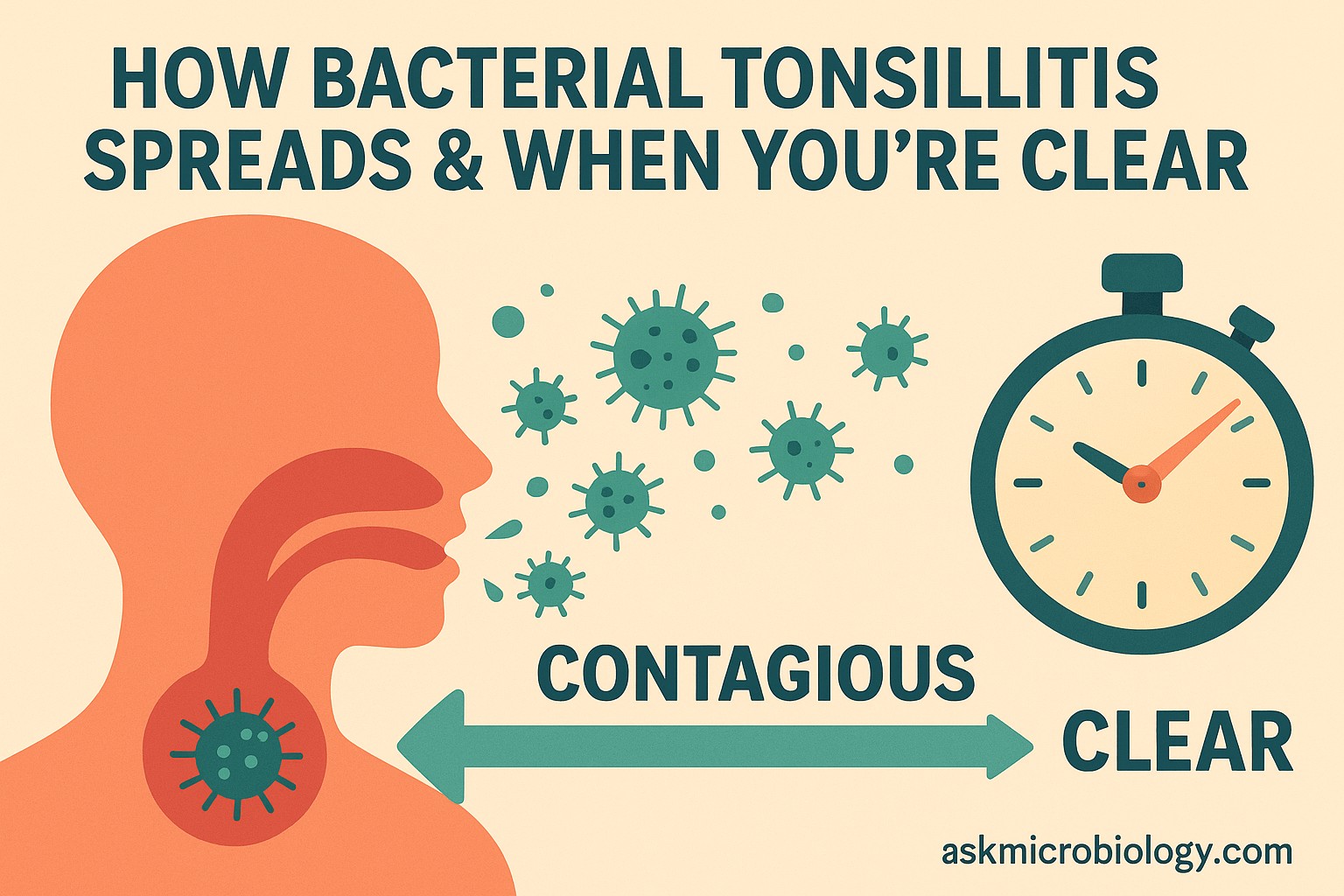Tonsillitis simply means inflammation of the tonsils due to an infection. When it’s “bacterial tonsillitis,” the infection is caused by bacteria (rather than a virus). The most common culprit is Group A Streptococcus – the bacteria responsible for strep throat. In fact, many people use “strep throat” and tonsillitis interchangeably when talking about bacterial cases. It’s worth noting that while viruses cause most cases of tonsillitis, about 1 in 4 cases (or more) are due to bacteria. Bacterial tonsillitis tends to cause more severe symptoms than the viral kind. You might experience a very sore throat that comes on quickly, fever, swollen tender lymph nodes in your neck, and often see white patches on the tonsils (those are pockets of pus)1,2. Another clue it’s bacterial rather than viral is that you usually won’t have a cough or runny nose with strep – it’s mostly the throat and lymph nodes under attack.
Doctors confirm bacterial tonsillitis by doing a throat swab. If the rapid strep test or culture comes back positive, you have a strep infection and will be prescribed antibiotics to treat it. Treating bacterial tonsillitis is important not just to make you feel better, but also to prevent complications (like rheumatic fever) and to stop the spread to others. Now, let’s talk about how this infection travels from person to person.
How Does Bacterial Tonsillitis Spread?
Bacterial tonsillitis (such as strep throat) spreads the same way many respiratory infections do – through microscopic droplets and direct contact. For example, when someone with strep throat coughs or sneezes, tiny droplets full of bacteria fly out into the air3. If you’re nearby and inhale those droplets, the bacteria can take up residence in your throat and tonsils. Even just talking closely or sharing a laugh in close quarters can send some droplets across short distances.
Another common way of spreading is via saliva contact. If you were to share a drink, eating utensils, or a toothbrush with an infected person, it’s an open invitation for their bacteria to move over to you4. Kissing, of course, can also transfer saliva and bacteria readily.
It’s also possible to catch these bacteria from touching contaminated surfaces. Think about a child with strep throat who wipes their nose or mouth and then touches a doorknob or a toy. The next person to touch that object might get the bacteria on their hands. If that person then rubs their nose or eats something with their hands without washing, the bacteria can enter their system. Group A strep can survive on surfaces for a little while (not forever, but long enough to pose a risk in the short term). This is why in schools, you’ll often see strep throat cases spread among classmates – they’re in close contact and touching all the same stuff all day.
It’s important to emphasize: bacterial tonsillitis is contagious even before you feel sick. In fact, you can start spreading the bacteria 1-2 days before your symptoms appear5. So someone might be passing strep around on Monday even though their throat doesn’t start hurting until Tuesday. Once symptoms do kick in, you remain contagious until you get treated and the bacteria are cleared from your system.
How Long Are You Contagious (When Can You Be Around Others Again)?
The timeline for contagiousness in bacterial tonsillitis is a bit different from viral infections because of the effect of antibiotics. Here’s what to keep in mind:
- Without treatment: If you do not take antibiotics, you can be contagious for as long as you have symptoms and even a bit beyond. Some sources indicate untreated strep throat can potentially spread to others for about two weeks6. Essentially, as long as the bacteria are thriving in your throat, they can potentially spread to someone else. This doesn’t mean you’ll definitely infect others that whole time (especially as your symptoms wane, you might be shedding less bacteria), but the risk is there.
- After starting antibiotics: Fortunately, appropriate antibiotics drastically shorten the contagious period. Once you’ve begun antibiotic treatment, you’re typically not contagious after about 24 hours (some doctors say up to 24-48 hours to be extra safe)7,8. By the one-day mark on antibiotics, the bacterial count in your throat usually drops low enough that you’re unlikely to spread it. This assumes you also no longer have a fever and are starting to feel a bit better. That’s why doctors and public health guidelines say you can usually return to work or school after a full day on antibiotics, provided you feel well enough and don’t have a fever.
- During treatment: Until you’ve hit that 24-hour mark on antibiotics, you should still consider yourself contagious. It might feel frustrating – you’ve started treatment, maybe you feel a slight improvement, but you shouldn’t rush back into social situations yet. Give the medicine time to work. Completing the full course of antibiotics is also crucial, even though you’re not contagious after a day or two. Finish all your pills to ensure the infection is truly gone and to prevent it from flaring back up.
One more thing: what about those rare cases of being a carrier? A small number of people can carry strep bacteria in their throat without currently feeling sick. They might test positive for strep (for example, during a family strep outbreak, one member tests positive but feels fine). Carriers are generally much less contagious than someone who is acutely ill, because the bacteria may not be in an active growth phase. So if you had bacterial tonsillitis, got treated, and fully recovered, the odds of you continuing to spread germs are very low. We mostly worry about contagion during the active infection.
Summary of timeline: You can spread bacterial tonsillitis starting a couple days before you know you’re sick, and until at least 24 hours of antibiotics are completed. Practically speaking, doctors often advise that you’re “clear” to be around others once you’ve had a full day of antibiotics and are feeling better. If you’re ever in doubt, a good rule is to wait an extra day – no one will complain about you taking an extra sick day to be

.
Tips to Prevent Spreading Bacterial Tonsillitis
If you or a family member has bacterial tonsillitis, you’ll want to protect others from catching it. Here are some friendly reminders on prevention steps (they may sound like common sense, but they really do help):
- Stay home while contagious: This one’s simple. If you’ve been diagnosed with strep or another bacterial throat infection, keep yourself (or your child) at home until the doctor’s okay with you returning. Usually, as mentioned, that’s at least 24 hours on antibiotics. Rest up – your body heals faster when you take it easy.
- Hand hygiene is your best friend: Wash your hands frequently with soap and water, and encourage everyone in the household to do the same. After you cough, sneeze, or touch your face, clean those hands. Alcohol-based hand sanitizers are a good backup if you can’t get to soap and water immediately.
- Cover that cough/sneeze: Use the crook of your elbow or a tissue to cover your mouth when coughing or sneezing. This keeps droplets from flying out into the room. Dispose of used tissues promptly and wash up afterwards. It’s a small habit that can contain the bacteria to just you.
- No sharing until recovered: Make sure the person with tonsillitis has their own drinking glass, utensils, toothbrush, etc., separate from everyone else’s9. Wash their dishes in hot soapy water. It might even be worth rinsing the toothbrush in boiling water or replacing it after a couple days on antibiotics, as it could harbor some bacteria.
- Clean surfaces: Wipe down surfaces that the sick person touches often. Focus on things like doorknobs, faucet handles, remote controls, and cell phones. A household cleaner or disinfectant wipe can kill the bacteria on surfaces, reducing the chance others in the house pick it up.
- Keep laundry separate: If the sick person has been drooling on pillowcases or using a bunch of handkerchiefs, wash those items separately in hot water. This prevents bacteria from those items potentially spreading to others’ laundry.
- Educate the family: If you have kids, this is a good time for a gentle reminder about not putting random objects (or their fingers) in their mouth, especially when someone at home is sick. Also teach them about proper handwashing and not getting too close to a sibling’s face when the sibling is ill.
- Take your medicine as directed: From an individual standpoint, the quicker you eliminate the infection, the less chance you have to spread it. So, by taking your antibiotics exactly as prescribed (don’t skip doses and finish the bottle), you’re also doing your part in preventing spread. Stopping antibiotics early can sometimes lead to the bacteria coming back – and that means contagious again.
By following these precautions, many people get through a bout of strep or bacterial tonsillitis without infecting the rest of their family. It’s not a 100% guarantee, but it tilts the odds in your favor.
When Are You “In the Clear”?
To wrap up, bacterial tonsillitis is contagious, but you won’t be contagious forever. You’re most infectious in the early stages of illness (right before and after symptoms start). If untreated, you could spread germs for a couple of weeks, but with prompt antibiotics, you’ll usually stop being contagious about a day after starting the medication10. The combination of taking your antibiotics and practicing good hygiene is key to protecting those around you. So, rest up, take your meds, and in a day or two you should be able to give your loved ones a hug without worry. And of course, if you have any concerns – for example, if you’re still feeling very sick after a few days or unsure about when it’s safe to resume normal activities – check back with your healthcare provider for guidance.
References:
- ENT Medical and Surgical Group. Is Bacterial Tonsillitis Contagious? (2024) – Confirms that strep (bacterial) tonsillitis spreads via respiratory droplets and direct contact, and notes you can start spreading it 1-2 days before symptoms appear. Also states that after starting antibiotics, you’re typically not contagious after 24 hours.
- Is Tonsillitis Contagious? – Provides general contagious periods, indicating bacterial tonsillitis can remain contagious for about two weeks if untreated, but that antibiotics usually render a person non-contagious in 24-48 hours.
- Granville Health System (GHS). How Long You’re Infectious & What to Do (2024) – Explains that for bacterial tonsillitis (Group A Strep), transmission risk drops after 24 hours of effective antibiotics, and generally you’re contagious from symptom onset until 24-48 hours of treatment. Emphasizes good hygiene and avoiding close contact during that period.
- Mayo Clinic via American Family Care. Strep Throat vs. Tonsillitis – Describes how strep throat is transmitted through sneezes, coughs, or sharing items, and notes children in close contact are at high risk. Also covers that rapid testing and antibiotics are used once strep is diagnosed.
- ENT Medical and Surgical Group. Prevention of Bacterial Tonsillitis – Recommends hygiene practices like handwashing, not sharing utensils, covering mouth when coughing/sneezing, and disinfecting surfaces to reduce the spread of infection. These measures are echoed by public health advice for containing strep infections.

